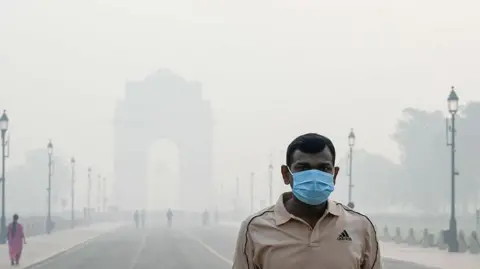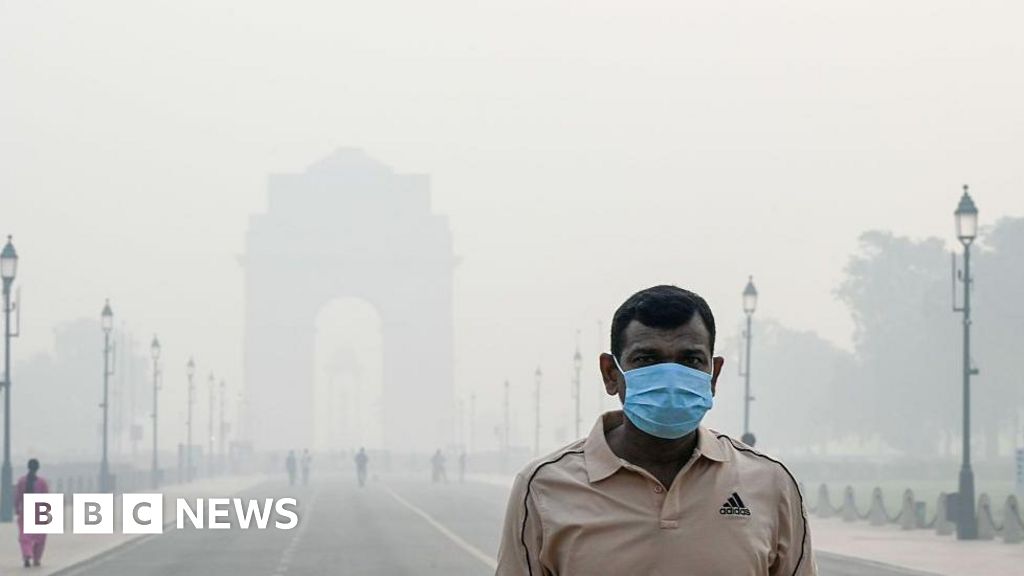Nikita YadavBBC News, Delhi

Every year, like clockwork, Delhi chokes.
A thick, toxic haze settles over the city – stinging eyes, burning throats and sending air quality monitors into panic mode.
For the past few days, the air in Delhi and its neighbouring satellite cities has hovered between the “poor” and “very poor” categories.
It worsened sharply after Diwali, one of India’s biggest festivals, as fireworks lit up the night sky and filled the air with smoke. Headlines reported that it was the worst post-Diwali air quality the city had experienced in the past four years.
With that, the city once again found itself confronting its annual, predictable – yet avoidable – crisis: air pollution.
There isn’t a single factor to blame for the toxic air.
It’s a combination of events – firecrackers, vehicular emissions and the burning of crop residue in the agrarian states of Punjab, Haryana and Uttar Pradesh – that leads to the same outcome every year. And as it coincides with the start of winter, colder temperatures and low wind speeds trap pollutants close to the ground.
This year too, the same factors are believed to be at play – although there are contradictory reports about what contributed how much to the toxic air this year.
Indian media reports, citing a climate research firm, say there has been a 77% decline in stubble-burning incidents this year because of the devastating floods that destroyed much of the region’s crops earlier. It blames firecrackers as being the main cause for Delhi’s poor air during the festive period.
But official data from Punjab tells a different story, PTI news agency reported. According to the regional pollution control board, stubble-burning incidents in the state have gone up three times in the past 10 days, with more than 350 cases reported – up from just 116 recorded until 11 October.
In the past few years, authorities have launched targeted campaigns to highlight the harmful impact of stubble burning and to promote the use of machinery as an alternative.
These efforts have shown some results on the ground. For instance, farm fires in Punjab fell to 10,909 cases last year as against 36,663 in 2023. But despite the decline, it continues for a simple reason: affordability. It remains the cheapest way to clear fields.
And while successive governments have spoken about providing machinery and financial incentives to discourage crop burning, very little has changed on the ground.
The other major contributor to Delhi’s pollution in this season is firecrackers.
Just days before the Diwali festival, India’s top court relaxed a five-year ban on selling and bursting of crackers in Delhi and surrounding areas. It permitted the use of less-polluting “green crackers” for six hours over two days over the festival. Experts criticised the order saying “green crackers” are only 20-to-30% less polluting and still release harmful particles that degrade air quality.
Also, the reality on the ground was far from what the court mandated and the restrictions were openly flouted.
In many parts of the capital, fireworks started early in the morning and continued well past midnight. And not all of them were “green crackers” either. In the run-up to Diwali, BBC reporters saw more polluting crackers also being sold openly in shops.
The polluted air that people are being forced to breathe has residents complaining of coughing, watery eyes and breathlessness. And doctors say long-term exposure gradually weakens the body’s natural defences, making people more prone to a host of serious ailments.
Yet, the human cost of pollution rarely becomes a priority for the region’s elected representatives, as political parties resort to the familiar cycle of blame every year.
This year too, the Delhi government and the one in Punjab have been engaged in a war of words.
Delhi’s Environment Minister Manjinder Singh Sirsa accused Punjab officials of “forcing farmers to burn stubble” to deliberately worsen the capital’s air.
The Aam Aadmi Party (AAP), which governs Punjab, dismissed the allegations and, in turn, accused the Delhi government of “lying about pollution” and “playing with people’s lives”.
Meanwhile, experts and some citizens say the only way forward is through collective, long-term solutions, where both state and federal governments work together rather than relying on temporary, reactionary pollution control measures each winter.
For now, as winter creeps in, Delhi and much of northern India choke once again – a tragic annual routine that shows no signs of ending.
Follow BBC News India on Instagram, YouTube, X and Facebook.
